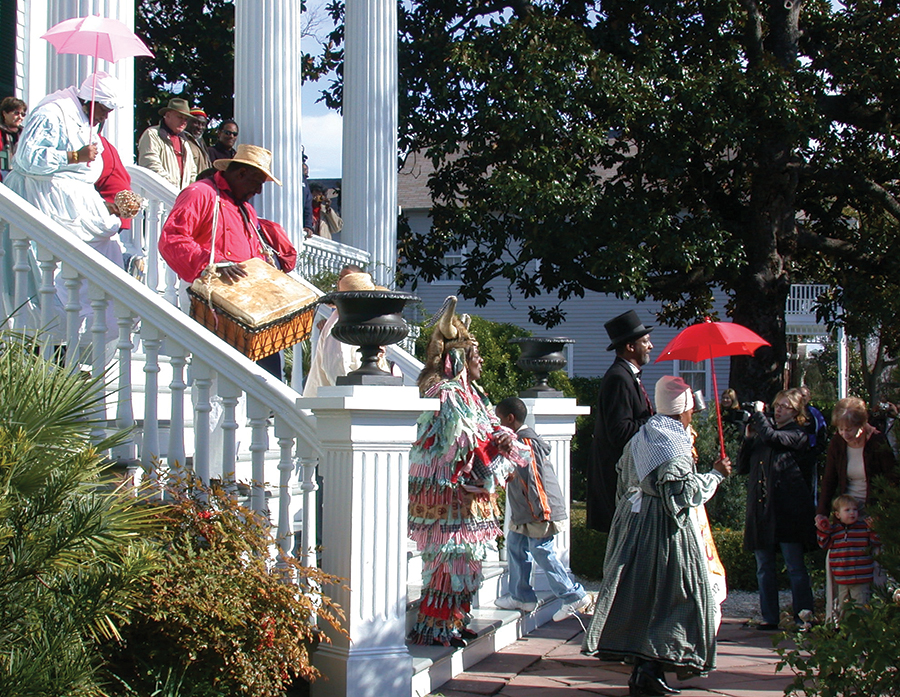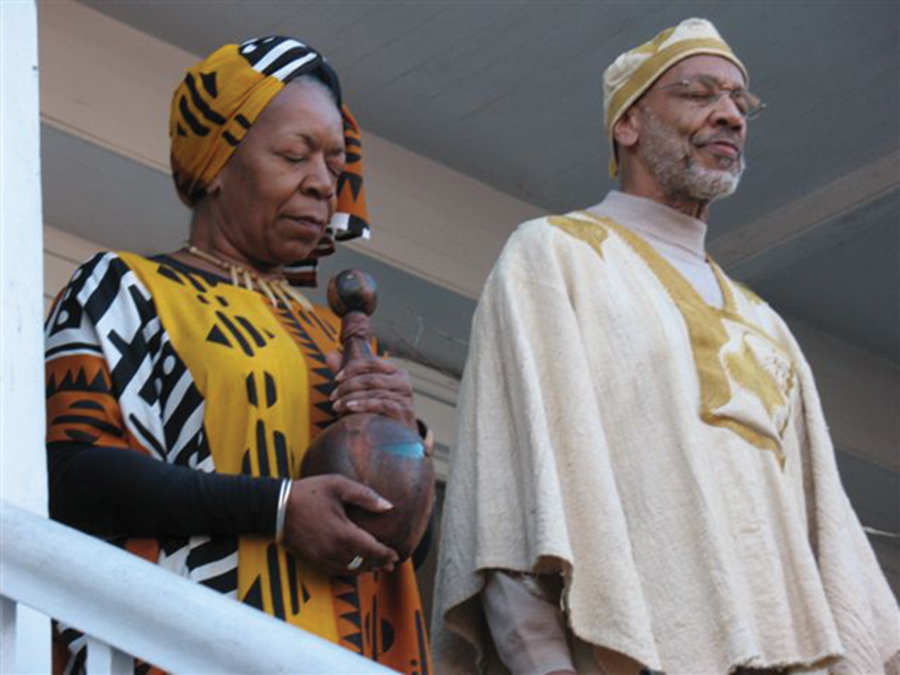History with a beat
By Kevin Maurer • Photographs courtesy of Bellamy Mansion Museum
The first time Keith McClease picked up the “gumba box,” he felt something.
An energy. Spirits, maybe?
As McClease tapped out the beat on the box-shaped drum covered with sheepskin, he felt a link to the past. It was 2000 and Tryon Palace in New Bern was holding its first Jonkonnu, a traditional African-American celebration dating back to the 1700s. It was held on the day after Christmas, when slaves in eastern North Carolina celebrated one day of freedom with music, dancing and costumes.
For weeks, McClease trained with two experts on African drumming and songs. He played everything by ear, picking up the songs quickly.
“You’ve got it inside,” one of the teachers told McClease.
He could feel it, too. Each beat. Each step as they practiced, the parade took him into the past. Took him back to his ancestors.
“It’s spiritual for me,” said McClease, Tryon Palace’s garden operations supervisor, who serves as the master drummer during the Jonkonnu parade in New Bern. “I felt like I could really feel what they felt. I was bringing back something pushed back in time and covered up.”
Traditionally celebrated between Christmas and New Year’s Day, Jonkonnu is unique to eastern North Carolina. Widely practiced in Wilmington until the early 1900s, the festival was a brief respite from the horrors of slavery, a chance for slaves to shed their bondage for at least a day.
“I think it could be a time of joy,” says Elizabeth Fenn, who wrote the definitive piece on the festival in an April 1988 article in the North Carolina Historical Review. “It was a time of opportunity in the sense that it was a moment when the rules were called off and people could express themselves in ways they couldn’t in other times of the year.”
The festival— which is now re-enacted in New Bern every December and in the past at Wilmington’s Bellamy Mansion — was the only chance for slaves to honor birthdays, births and weddings with two forbidden activities, drumming and dancing, says Sharon C. Bryant of Tryon Palace.

DEEP ROOTS
While the origin of its name – Jonkonnu (pronounced John Canoe) – remains a mystery, the festival started in Africa before coming to the first slave communities in the Caribbean, and later in the 18th century to Wilmington and eastern North Carolina.
“It is an incredibly rich ceremony,” says Fenn. “It shows how influenced we all are by that Atlantic crossing. It does reflect cultural strains that existed under this sick institution.”
Fenn called North Carolina “a virtual island of the Jonkonnu on the North American continent,” but noted similar celebrations happened as far north as Suffolk, Virginia.
Regardless of locale, all the Jonkonnu had the same foundations – drums, singing, dancing and funky costumes made of rags or animal skins with horns. Schoolteacher Moses Ashley Curtis described the festival in Wilmington in his Dec. 25, 1830, diary entry:
“The (N)egroes have a singular custom here . . . of dressing out in rags & masks . . . They are accompanied by a troop of boys singing, bellowing, beating sticks, dancing & begging. Three or four of these John Cooners as they are (called) made their appearance today. One of them was completely enveloped in strips of cloth of every color which depended in the most ragged confusion from every part of his ebony hip. Over his face was drawn the nether part of a raccoon skin from the center of which hung the tail . . . On each side of that tail appeared two holes through which shone the whites of his eyes . . . Then dancing & his rags flying & his flexible nose gamboling about his face, singing with a gruff voice in concert with his satellites.”
The men — accompanied by spectators of both men and women — marched and danced from door to door in town, performing for their masters and white people or up to the master’s house, a privilege to all those slaves who worked in the house.
The performers were given money or liquor as a reward. But there was a bigger reward — a handshake. The master would shake hands with the performers, McClease said, adding that some of the spectators would often come out just to see it.
“It was the only time they could be equal to the white man,” said Simon Spalding, a musician and historian in New Bern who started the Jonkonnu tribute at Tryon Palace. “It was an opportunity to be able to express one’s life and energy.”
Wilmington’s Jonkonnu custom continued after the Civil War, according to newspaper reports from the time, but petered out by the 1900s, according to Fenn’s article. The Wilmington riots ended the festival, historians said. Jim Crow laws also discouraged the festival.
THE RETURN
But in New Bern, the festival has been reborn. For Bryant, who is the African-American outreach coordinator at Tryon Palace, the celebration is a way of connecting with her heritage.
“Slavery happened,” she says. “I take pride in knowing what my ancestors did here. I am very proud of what we do here at Tryon Palace. I like to teach people.”
Fenn’s article sparked the revival of the festival in the 1990s. One of the first re-enactments was at Wilmington’s Bellamy Mansion in 1995. The mansion held several Jonkonnu revivals in 2007 and 2008, but won’t be holding one in 2017.
“I’d be open to doing it again,” says Gareth Evans, the director of the Bellamy. “We stopped because this was a project of staff that had retired or moved on. I didn’t have the connections upon starting the job. Mostly, however, it was because we came up with other community programs around that time. It was simply a matter of trying to fit 60 events in a year and running out of space. Every year I try new things and Jonkonnu may well become an old ‘new’ idea here again soon.”
Spalding started working on starting a regular reenactment of Jonkonnu in New Bern. In the late ’90s, he was working full time at Tryon Palace and looking for ways to bring more African-American history into the living history experience.
“Part of it was just trying to make a more accurate and more inclusive interpretation of history,” Spalding says. “We have a lot of detail about the Tryons and other prominent white citizens of New Bern.”
Spalding majored in music at the University of California at Berkeley in the late 1970s. He’d studied Jamaican musical traditions and noticed the similarities in references about Jonkonnu. He had a hunch that the Jamaican tradition likely played into the Jonkonnu celebration in North Carolina.
Christmas is a special time and Tryon Palace’s candlelight tour attracts crowds. Spalding liked the idea of adding a Jonkonnu parade throughout the streets of New Bern. He came up with the plan, recruiting re-enactors and artisans to make the instruments and costumes.
“Some of those (African-American) stories we cover a little bit, but not as much as we should,” Spalding says.
The festival is now a staple of Tryon Palace’s Christmas celebration. Tryouts to join the Jonkonnu troupe were held over the summer and the 2017 Jonkonnu shows start in early December.

‘STEAM VALVE’
While it was a celebration, Fenn, who is now teaching history at the University of Colorado — Boulder, called the festival needed relief from the horrors of slavery.
“(Slave owners) did it out of a sense if they didn’t do it, complete repression year-round would result in an uprising, rebellion and resistance,” says Fenn. “It’s a steam valve. I think it was calculated. Slave owners weren’t doing anything out of the goodness of their hearts.”
Bryant said there was some resistance to holding the re-enactment at Tryon Palace. She said in Wilmington the festival wasn’t welcome because of the stigma of slavery.
“A lot of friends think that it was wrong,” she said. “It feeds into that concept of slavery. It was the only time African- Americans were able to do something of their own. I don’t think it is degrading.”
But Bryant said that stigma is why Jonkonnu needs to be celebrated and remembered.
“People don’t like to talk about slavery,” she says. “Sometimes when you get a subject out, people can express how they feel about it. Share a story that needs to be told.”
She refuses to look at the dark side of the festival, and instead focuses on the good. For some participants, Jonkonnu was the only time they could leave the plantation and see family and friends. Bryant said it was a time to celebrate the year’s joys — weddings, births — and historians said it was a time to plan: Slaves would often use the time to pass messages about escape plans and some of the songs mocked the slave masters.
“They preferred to have a time to celebrate,” she said. “Three hundred sixty-four days of hard labor. They wanted to celebrate what God gave us. They prayed and took care of each other. One day they could celebrate.”
Spalding said before they started the series, Tryon Palace held open meetings with community leaders to discuss plans on holding a Jonkonnu event in Tryon Palace’s Christmas Candlelight Tours. He said Tryon Palace was trying to not repeat mistakes made by Colonial Williamsburg, which re-created a slave auction in 1994. News of the event was leaked, causing boycotts and protests.
Spalding said the reaction to Jonkonnu was positive.
“As it turned out, New Bern’s African-American community has embraced the re-creation of Jonkonnu, and to a great extent, made it their own,” he says. “I think people working in the museum/living history field have learned from the experience of Colonial Williamsburg’s slave auction program — it is best to include the African-American community from the very beginning, in any programs interpreting slavery.”
THE BAND PLAYED ON…
McClease, who will be in costume in December leading the parade, doesn’t get too wrapped up in the politics. The entertainment part of it is his focus.
It’s a show and he is a drummer.
You’ll see him this December in the front of the procession leading the line of dancing and drumming men and women. Rags spinning. Raccoon headdresses bobbing. The thump of the drums. The hum of the West African chant:
Funga alafia, ashay ashay! Funga alafia, ashay ashay!
The chant translates into a message of hope: “I welcome you into my heart.”
But behind the pageantry and the show, McClease is carrying on the fight for those before him. He is preserving a celebration for those who couldn’t celebrate. He is reminding us that even during one of the most shameful episodes in our country’s history, there was joy. There was rebellion. And that no matter how much we don’t want to acknowledge America’s original sin, it is there and can never be forgotten.
“Now I have an opportunity to bring it back out and it is a big responsibility,” he said. “A part of history that was blocked out.”
Tryon Palace in New Bern will hold Jonkonnu performances December 9 & 16 at 6:00 p.m. and 8:00 p.m. Admission is free. For more information, log on to tryonpalace.org/jonkonnu or call 252-639-3592.
Kevin Maurer is an award-winning journalist who lives in Wilmington. His latest book is American Radical: Inside the World of an Undercover Muslim FBI Agent.


